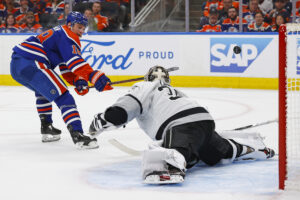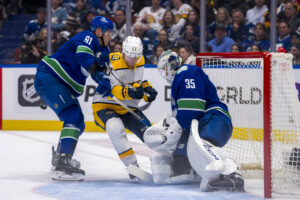When looking at all professional sports, it is pretty easy to determine that ice hockey has seen some of the most dramatic changes over time. This is especially true and noticeable in the equipment used. Not long ago, goaltenders wore masks directly on their faces while forwards had the option to wear a helmet or not. Fast forward to today’s NHL, and players appear drastically different than their counterparts from 35, 25 or even just 15 years ago.
Hockey gear develops year after year, with the newest items being “lighter”, “more protective”, “more comfortable”, “performance-enhanced”, and so on.
Players Turning into On-ice Gladiators, Hockey Equipment Largely to Blame
Simultaneously, the game’s athletes are training harder. Players are taller, heavier, faster and stronger than ever before. The NHL is an extremely fast league, as rules have changed in the past two decades to allow for this as well (particularly, cutting down on obstruction, and the removal of the two-line pass infraction).
Cutting Down Concussions without Sacrificing Speed
The problem now is that all these heavier, stronger athletes are flying around faster than ever before. While some argue the red line should be reintroduced to slow things back down, sacrificing speed would force everything to adjust again. It took quite some time for players to adjust to the faster game. Now we see superstars like Nathan MacKinnon and Connor McDavid showing everyone what is possible at a lightning-like pace.
So, what can be done?
As speed increases, collision speed does as well. Hockey equipment develops annually to try and counteract this. However, what we see now is enormous, rock-hard gear.
The shoulder pads are quickly approaching the size of those worn in football (just look at side-by-side images). The elbow pads are no longer a cushion just on the elbow, but a stiff, firm piece of gear extending well above and below the elbow.
Players can now effortlessly and painlessly slam their shoulders, hips and elbows into anything.
Time to Dial Back Gear Size
Developers successfully created lighter and more protective hockey equipment. The problem now is that it has become too hard and large. Players fearlessly charge into each other because of the fact they don’t feel the impact pain. However, this only applies when they are prepared.
For example, take the collision that caused Pittsburgh Penguins defenseman Brian Dumoulin to exit a game in the second round against the Washington Capitals. Dumoulin prepared to come in contact with Alex Ovechkin, but did not expect Tom Wilson to check him from the other side. This resulted in Wilson’s shoulder pad to directly catch Dumoulin’s head. The speed wasn’t very fast, nor was it an illegal hit since Dumoulin changed his positioning at the last minute to prepare for Ovechkin’s hit.
A 2005 shoulder pad would not have dealt the same dizzying blow that Wilson’s 2018 shoulder pad did.
Re-inforcing the Argument Made in “Ice Guardians”
Go watch various concussions through the past two to five years (not the infamous illegal ones, but the collisions). You’ll be surprised how many are from a shoulder or elbow pad clipping a player’s head.
ICYMI, I highly suggest watching “Ice Guardians” (available on Netflix). The film defends the enforcer role in the NHL, and in doing so it tackles the concussion debate head-on. Only five percent of NHL concussions come as a result of fighting, leaving the speed of the game and hockey equipment to make up a much larger percentage. Various doctors, analysts and ex-players in the film cite hockey equipment and its massive size as a cause that is emboldening players and making collisions more dangerous.
Modern Gear Needs to be Softer, not Harder
I’m not saying we make it less protective. I’m not saying we expose more skin.
But, I am saying that if I am chasing down a puck in the corner while an opponent is doing the same, I’ll be going in a hell of a lot faster and more headstrong with today’s gear on than I would with yesterday’s.
The technological advances in equipment haven’t all been bad. The coverage offered today is fantastic, as near to nothing is left exposed on players to direct skin contact. There are awesome fabrics and forms that are designed to absorb impact too.
Elbow and shoulder pads, though, appear more designed to enhance the impact taken by an opponent, rather than mute it.
Regulating Hockey Equipment could Help Reduce Concussions
The NHL needs to take a hard look at these huge, stone-like pieces of gear and start creating some regulations. There should be a certain amount of “give” that each item has to have. They’d likely have to do impact testing before approving lines of equipment for use to measure things like absorption, elasticity, flexibility, and so on.
A seemingly good rule of thumb: a piece of gear cannot deal more damage than it is designed to prevent.
And hey, this is not a crazy idea. The NHL already regulates plenty of gear as it is. Goalies have extremely rigorous guidelines for nearly every piece of equipment they wear. Player sticks have pretty fine limitations as well. It is time they do the same for other hockey equipment. The end goal must be the removal of weapon-like shoulder and elbow pads to decrease injuries caused by those items.






